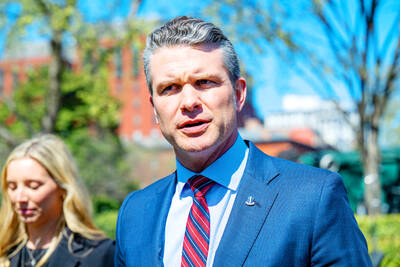What kind of headline-grabbing rhetoric can be expected from President Chen Shui-bian (陳水扁) when he stumps for Democratic Progressive Party (DPP) legislative candidates this weekend?That's the question hovering over many people's minds.
Chen's aggressive campaigning over the past two weeks -- and the variety of subjects he has raised -- has not only left the pan-blue camp hard-pressed, but left some members of the pan-green camp struggling to keep up with him.
DPP legislative candidate Chang Ching-fang (張清芳), seeking a seat in Taipei County, has complained that "President Chen is running too fast" in term of throwing out campaign subjects in the run-up to the Dec. 11 polls.
Since hitting the campaign trail on Nov. 12, Chen, who doubles as the DPP's chairman, has grabbed center stage with issues ranging from setting up a Taiwan truth investigation committee to allegations of a "soft coup" attempted by the pan-blue camp to demanding the Chinese Nationalist Party (KMT) change its party emblem or else he would try to amend the National Emblem Law in order to allow the government to force the party to make the change.
His combativeness and ideas have stirred up heated discussion in the media and among voters.
When asked about grumbling within the DPP about Chen's pace in launching campaign topics, Secretary-General of the Presidential Office Su Tseng-chang (
"All issues thrown out by President Chen have gone through careful consideration and reflection," Su said.
"Although some people have said that Chen's pace is too quick for them to catch up, generally speaking, his moves are helpful to the [pan-green's] electoral outlook as a whole," Su said.
A majority of DPP members have given the thumbs up to Chen's rhetoric.
"I think the range of issues launched by President Chen are helpful to our electoral outlook," said DPP caucus whip Tsai Huang-liang (
A quick review of recent news coverage of the campaign indicates the pan-green camp appears to have gained the upper hand in directing the campaign debate. Both the KMT and the People First Party (PFP) appear to be stuck in a defensive mode, reactive rather than pro-active.
Chin Heng-wei (金恆煒), editor-in-chief of Contemporary Monthly magazine, said that the pan-blue camp only went on the offensive when KMT Chairman Lien Chan (連戰) challenged Chen to have the DPP propose a referendum be held on the issue of unification or independence alongside the legislative polls.
"By introducing such an idea, the pan-blue camp hoped to gain territory and dominate the campaign discussion," Chin said. "Chen spiked the move with his reminder to Lien that it was the pan-blue camp who passed the so-called `bird-cage' Referendum Law (
Instead of scoring a point for the pan-blues, Lien's referendum remarks revealed his ignorance of the Referendum Law, Chin said.

A magnitude 4.9 earthquake struck off Tainan at 11:47am today, the Central Weather Administration (CWA) said. The hypocenter was 32.3km northeast of Tainan City Hall at a depth of 7.3km, CWA data showed. The intensity of the quake, which gauges the actual effect of a seismic event, measured 4 in Tainan and Chiayi County on Taiwan's seven-tier intensity scale, the data showed. The quake had an intensity of 3 in Chiayi City and County, and Yunlin County, while it was measured as 2 in Kaohsiung, Nantou County, Changhua County, Taitung County and offshore Penghu County, the data showed. There were no immediate reports of

‘DENIAL DEFENSE’: The US would increase its military presence with uncrewed ships, and submarines, while boosting defense in the Indo-Pacific, a Pete Hegseth memo said The US is reorienting its military strategy to focus primarily on deterring a potential Chinese invasion of Taiwan, a memo signed by US Secretary of Defense Pete Hegseth showed. The memo also called on Taiwan to increase its defense spending. The document, known as the “Interim National Defense Strategic Guidance,” was distributed this month and detailed the national defense plans of US President Donald Trump’s administration, an article in the Washington Post said on Saturday. It outlines how the US can prepare for a potential war with China and defend itself from threats in the “near abroad,” including Greenland and the Panama

The Chinese Nationalist Party (KMT) is maintaining close ties with Beijing, the Democratic Progressive Party (DPP) said yesterday, hours after a new round of Chinese military drills in the Taiwan Strait began. Political parties in a democracy have a responsibility to be loyal to the nation and defend its sovereignty, DPP spokesman Justin Wu (吳崢) told a news conference in Taipei. His comments came hours after Beijing announced via Chinese state media that the Chinese People’s Liberation Army’s Eastern Theater Command was holding large-scale drills simulating a multi-pronged attack on Taiwan. Contrary to the KMT’s claims that it is staunchly anti-communist, KMT Deputy

RESPONSE: The government would investigate incidents of Taiwanese entertainers in China promoting CCP propaganda online in contravention of the law, the source said Taiwanese entertainers living in China who are found to have contravened cross-strait regulations or collaborated with the Chinese Communist Party (CCP) could be subject to fines, a source said on Sunday. Several Taiwanese entertainers have posted on the social media platform Sina Weibo saying that Taiwan “must be returned” to China, and sharing news articles from Chinese state media. In response, the Mainland Affairs Council (MAC) has asked the Ministry of Culture to investigate whether the entertainers had contravened any laws, and asked for them to be questioned upon their return to Taiwan, an official familiar with the matter said. To curb repeated